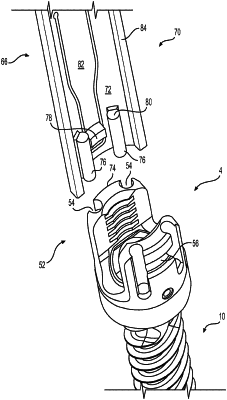| CPC A61B 17/7083 (2013.01) [A61B 17/70 (2013.01); A61B 17/7035 (2013.01); A61B 17/7076 (2013.01); A61B 17/80 (2013.01); A61B 17/863 (2013.01); A61B 17/864 (2013.01); A61F 2/44 (2013.01)] | 7 Claims |

|
1. An elongated blade that is configured to connect to a tulip housing that is in turn connected to a head portion of a bone anchor; said elongated blade comprises first and second blade members; said first and second blade members are spaced apart from one another along a majority of a longitudinal length of said elongated blade; each of said first and second blade members includes first and second rotational locking features that are spaced apart from one another; each of said first and second rotational locking features is positioned on an interior surface of each of said first and second blade members and extends toward a central axis of said elongated blade; each of said first and second rotational locking features has a substantially cylindrical shape; each of said first and second blade members includes an axial locking feature that is positioned between said first and second rotational locking features; each of said axial locking features is positioned on an interior surface of each of said first and second blade members and extends toward said central axis of said elongated blade; each of said axial locking features is positioned on a living hinge that is formed in said first and second blade members; each of said first and second rotational locking features has a longitudinal length along a longitudinal axis of said elongated blade that is greater than a longitudinal length of each of said axial locking features along said longitudinal axis of said elongated blade; each of said first and second rotational locking features has a longitudinal axis that is parallel to said central axis of said elongated blade; and
wherein each of said rotational locking features on each of said first and second blade members is configured to limit rotational movement of said elongated blade relative to the tulip housing when said rotational locking features are in engagement with the tulip housing; and
wherein said axial locking feature on each of said first and second blade members is configured to limit axial movement of said elongated blade relative to the tulip housing when said axial locking features are in engagement with the tulip housing; and
wherein said first and second blade members each have an exterior surface that has a curved shaped; said interior surface of each of said first and second blade members has a curved shape; each of said first and second blade members has a mirrored shape from another; and
wherein said living hinge on each of said first and second blade members has a narrow width portion and wide width portion; said narrow width portion is positioned below said wide width portion; an interior surface of said narrow width portion fully includes said axial locking feature.
|